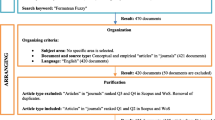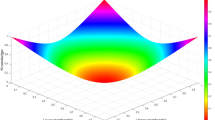Abstract
Pythagorean fuzzy similarity measures being an extension of classical fuzzy similarity measures give a better assessment of the closeness of two uncertain feature spaces. In this paper, we introduce the notion of Pythagorean fuzzy equivalences and derive some mathematical results to facilitate the derivation of some novel methods of construction of similarity measures in the Pythagorean fuzzy framework. In fact, we utilize Pythagorean fuzzy equivalences and aggregation operators for the construction of a class of similarity measures. We established the accuracy and advantages of the proposed Pythagorean fuzzy similarity measures by considering several benchmark datasets in a numerical experiment.

Similar content being viewed by others
Data availability
The data supporting this study's findings is artificial and can directly be referred from this manuscript.
References
Yager RR (2013) Pythagorean fuzzy subsets. In: 2013 Joint IFSA World Congress and NAFIPS Annual Meeting (IFSA/NAFIPS). IEEE, pp 57–61
Zadeh LA (1965) Fuzzy sets. Inf Control 8:338–353. https://doi.org/10.1016/S0019-9958(65)90241-X
Atanassov KT (1986) Intuitionistic fuzzy sets. Fuzzy Sets Syst 20:87–96. https://doi.org/10.1016/S0165-0114(86)80034-3
Nguyen XT, Nguyen VD, Nguyen VH, Garg H (2019) Exponential similarity measures for Pythagorean fuzzy sets and their applications to pattern recognition and decision-making process. Complex Intell Syst 5:217–228. https://doi.org/10.1007/s40747-019-0105-4
Agheli B, Adabitabar Firozja M, Garg H (2022) Similarity measure for Pythagorean fuzzy sets and application on multiple criteria decision making. J Stat Manag Syst 25:749–769. https://doi.org/10.1080/09720510.2021.1891699
Saikia B, Dutta P, Talukdar P (2023) An advanced similarity measure for Pythagorean fuzzy sets and its applications in transportation problem. Artif Intell Rev. https://doi.org/10.1007/s10462-023-10421-7
Tversky A (1977) Features of similarity. Psychol Rev 84:327–352. https://doi.org/10.1037/0033-295X.84.4.327
Wang PZ (1983) Fuzzy sets and its applications. Shangai Sci Technol Press
Xuecheng L (1992) Entropy, distance measure and similarity measure of fuzzy sets and their relations. Fuzzy Sets Syst 52:305–318. https://doi.org/10.1016/0165-0114(92)90239-Z
Chen SM (1997) Similarity measures between vague sets and between elements. IEEE Trans Syst Man Cybern Part B 27:153–158. https://doi.org/10.1109/3477.552198
Adlassnig KP (1986) Fuzzy set theory in medical diagnosis. IEEE Trans Syst Man Cybern 16:260–265. https://doi.org/10.1109/TSMC.1986.4308946
Chen SM, Tan JM (1994) Handling multicriteria fuzzy decision-making problems based on vague set theory. Fuzzy Sets Syst 67:163–172. https://doi.org/10.1016/0165-0114(94)90084-1
Lee Kwang H, Song YS, Lee KM (1994) Similarity measure between fuzzy sets and between elements. Fuzzy Sets Syst 62:291–293. https://doi.org/10.1016/0165-0114(94)90113-9
Hong DH, Kim C (1999) A note on similarity measures between vague sets and between elements. Inf Sci (Ny) 115:83–96. https://doi.org/10.1016/S0020-0255(98)10083-X
Li F, Xu ZY (2001) Measures of similarity between vague sets. J Softw 12:922–927
Singh K, Singh S (2023) Normal KN functions-based fuzzy information measures with applications in MADM and pattern recognition. Inf Sci. https://doi.org/10.1016/j.ins.2023.119297
Dengfeng L, Chuntian C (2002) New similarity measures of intuitionistic fuzzy sets and application to pattern recognitions. Pattern Recognit Lett 23:221–225. https://doi.org/10.1016/S0167-8655(01)00110-6
Mitchell H (2003) On the Dengfeng-Chuntian similarity measure and its application to pattern recognition. Pattern Recognit Lett 24:3101–3104. https://doi.org/10.1016/S0167-8655(03)00169-7
Liang Z, Shi P (2003) Similarity measures on intuitionistic fuzzy sets. Patt Recognit Lett 24:2687–2693. https://doi.org/10.1016/S0167-8655(03)00111-9
Hung W-L, Yang M-S (2004) Similarity measures of intuitionistic fuzzy sets based on Hausdorff distance. Patt Recognit Lett 25:1603–1611. https://doi.org/10.1016/j.patrec.2004.06.006
Li Y, Olson DL, Qin Z (2007) Similarity measures between intuitionistic fuzzy (vague) sets: A comparative analysis. Patt Recognit Lett 28:278–285. https://doi.org/10.1016/j.patrec.2006.07.009
Ye J (2011) Cosine similarity measures for intuitionistic fuzzy sets and their applications. Math Comput Model 53:91–97. https://doi.org/10.1016/j.mcm.2010.07.022
Boran FE, Akay D (2014) A biparametric similarity measure on intuitionistic fuzzy sets with applications to pattern recognition. Inf Sci (Ny) 255:45–57. https://doi.org/10.1016/j.ins.2013.08.013
Singh K, Singh S (2023) On a dual proximity measure based on intuitionistic fuzzy sets. Neural Comput Appl 35:6293–6311. https://doi.org/10.1007/s00521-022-07946-3
Dhyani M, Kushwaha GS, Kumar S (2022) A novel intuitionistic fuzzy inference system for sentiment analysis. Int J Inf Technol 14:3193–3200. https://doi.org/10.1007/s41870-022-01014-8
Malik SC, Raj M, Thakur R (2023) Weighted correlation coefficient measure for intuitionistic fuzzy set based on cosine entropy measure. Int J Inf Technol. https://doi.org/10.1007/s41870-023-01384-7
Kaur P (2017) Intuitionistic fuzzy sets based credibilistic fuzzy C-means clustering for medical image segmentation. Int J Inf Technol 9:345–351. https://doi.org/10.1007/s41870-017-0039-2
Taruna AHD, Tiwari P (2021) A new parametric generalized exponential entropy measure on intuitionistic vague sets. Int J Inf Technol 13:1375–1380. https://doi.org/10.1007/s41870-021-00655-5
Wei G, Wei Y (2018) Similarity measures of Pythagorean fuzzy sets based on the cosine function and their applications. Int J Intell Syst 33:634–652. https://doi.org/10.1002/int.21965
Zeng W, Li D, Yin Q (2018) Distance and similarity measures of Pythagorean fuzzy sets and their applications to multiple criteria group decision making. Int J Intell Syst 33:2236–2254. https://doi.org/10.1002/int.22027
Peng X (2019) New similarity measure and distance measure for Pythagorean fuzzy set. Complex Intell Syst 5:101–111. https://doi.org/10.1007/s40747-018-0084-x
Peng X, Garg H (2019) Multiparametric similarity measures on Pythagorean fuzzy sets with applications to pattern recognition. Appl Intell 49:4058–4096. https://doi.org/10.1007/s10489-019-01445-0
Zhang Q, Hu J, Feng J, Liu A (2020) Multiple criteria decision making method based on the new similarity measures of Pythagorean fuzzy set. J Intell Fuzzy Syst 39:809–820. https://doi.org/10.3233/JIFS-191723
Peng X, Yuan H, Yang Y (2017) Pythagorean fuzzy information measures and their applications. Int J Intell Syst 32:991–1029. https://doi.org/10.1002/int.21880
Ejegwa PA (2020) Distance and similarity measures for Pythagorean fuzzy sets. Granul Comput 5:225–238. https://doi.org/10.1007/s41066-018-00149-z
Peng X, Yuan H (2021) Pythagorean fuzzy multi-criteria decision making method based on multiparametric similarity measure. Cognit Comput 13:466–484. https://doi.org/10.1007/s12559-020-09781-x
Fodor J, Roubens M (1994) Fuzzy preference modelling and multicriteria decision support. Kluwer Academic Publishers, New York
Kolesárová A (2001) Limit properties of quasi-arithmetic means. Fuzzy Sets Syst 124:65–71. https://doi.org/10.1016/S0165-0114(00)00125-1
Klement E, Mesiar R, Pap E (2000) Triangular norms. Kluwer Academic Publishers, New York
Beliakov G, Pradera A, Calvo T (2007) Aggregation functions: a guide for practitioners. Springer, Berlin Heidelberg, Berlin, Heidelberg
Chen S-M, Chang C-H (2015) A novel similarity measure between Atanassov’s intuitionistic fuzzy sets based on transformation techniques with applications to pattern recognition. Inf Sci (Ny) 291:96–114. https://doi.org/10.1016/j.ins.2014.07.033
Zhang X (2016) A novel approach based on similarity measure for pythagorean fuzzy multiple criteria group decision making. Int J Intell Syst 31:593–611. https://doi.org/10.1002/int.21796
Dhyani M (2022) A novel intuitionistic fuzzy inference system for sentiment analysis. Int J Inf Technol 14:3193–3200. https://doi.org/10.1007/s41870-022-01014-8
Acknowledgements
The authors would like to thank the anonymous referee and editor-in-chief for their constructive suggestions for the improvement of the paper.
Author information
Authors and Affiliations
Corresponding author
Ethics declarations
Conflict of interest
The authors declare that there are no conflicts of interest.
Ethical approval
This article does not contain any studies with human participants or animals performed by any of the authors.
Rights and permissions
Springer Nature or its licensor (e.g. a society or other partner) holds exclusive rights to this article under a publishing agreement with the author(s) or other rightsholder(s); author self-archiving of the accepted manuscript version of this article is solely governed by the terms of such publishing agreement and applicable law.
About this article
Cite this article
Singh, K., Singh, S. Novel construction method for Pythagorean fuzzy similarity measures. Int. j. inf. tecnol. 16, 2089–2097 (2024). https://doi.org/10.1007/s41870-023-01689-7
Received:
Accepted:
Published:
Issue Date:
DOI: https://doi.org/10.1007/s41870-023-01689-7




